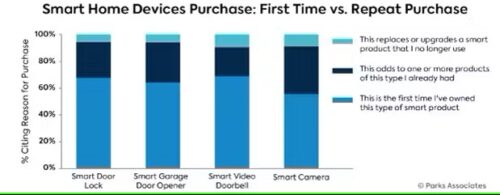
6.14.24 – SIW – Jennifer Kent
How to target first-time buyers, older consumers and more
This article originally appeared in the June 2024 issue of Security Business magazine. Don’t forget to mention Security Business magazine on LinkedIn and @SecBusinessMag on Twitter if you share it.
Consumers new to the smart home market are far closer to the mainstream consumer than to the early smart home adopter, who is often a product champion. For example, 30% of “newbies” (those who own 1-2 smart home devices) have a security system, the exact same adoption level for all U.S. internet households. By comparison, 71% of “super power users” own a security system.
The industry needs to focus on the benefits and messaging that will inspire these middle-market buyers to acquire their next 3-5 smart home devices. While they are underserved in security services, which is a universally appealing value proposition, messages must be more inclusive, focusing on the practical benefits and ease of integration into everyday life to appeal to this wider audience.

First-Time Buyers: Appealing Benefits and Routines
Like other buyer segments, new users are most likely to start with a video device. Among all smart home device categories, video doorbells are the highest adopted, with 22% of all U.S. internet households owning at least one by year-end 2023. Smart cameras are the second-best adopted category at 20% adoption. Furthermore, most recent purchases were made by buyers new to the category.
Consumers’ purchase intentions indicate video devices will continue to lead the way, starting at the front door. Video devices present an easily understandable value proposition, with their safety and security benefits widely appreciated.
Testing of unique benefits of smart home products and integrations, video also leads, with access control and safety use cases. Parks Associates tested 97 unique smart home routines, finding the most appealing smart home routines include comfort, productivity, and safety/security use cases, with scenarios such as automated locks, lights, and temperature adjustments outpacing entertainment-focused routines. This is especially true among newbies, who foremost value safety and security scenarios for themselves, their family members, and their homes.
Products enabling these benefits are available at a wide range of prices, with several different form factors for different locations and use-cases around the home: doorbell, camera, and floodlight. This combination of variety and familiarity offers a comfortable and affordable starting point for all consumers, regardless of socioeconomic status, to start and then expand their smart home.
While younger consumers command the most attention from emerging technology providers, more than 50 million U.S. consumers aged 65+ are among the later adopters of technology, presenting an enormous opportunity for market growth.
Embracing Older Consumers
While younger consumers command the most attention from emerging technology providers, more than 50 million U.S. consumers aged 65+ are among the later adopters of technology, presenting an enormous opportunity for market growth.
Older consumers show stronger interest than young consumers in several smart home routines, including viewing video outside of their main entrance, automated external lights, and HVAC/hot water heaters that adjust to save money based on home/away scenarios. These older consumers are underserved but have significant buying power. Utilities, lighting, and thermostat players that target these buyers would capture new sales, with the potential to expand their service portfolio.
Family caregivers are a similarly important market. About 11 million currently provide care for a loved one, and 15 million anticipate providing care for an elderly loved one within the next five years. These caregivers are in the “sandwich generation,” between the ages of 45 and 64, and roughly a third provide care both for children at home and for an aging parent or other loved one. These caregivers adopt new technology by necessity, and they view tech as helpful in managing the care of their family.
Consumers are far more interested in caregiving features than current usage indicates. Just 7% of smart home device owners use their devices to care for loved ones currently, but 77% are interested in a caregiving use-case.
The top preferred elements in DIY caregiving packages offer safety and security functionality. Fire/ smoke detection is the top desired feature of an independent living package, along with fall detection. Both indicate anxiety about a loved one’s ability to be helped in severe emergencies. Smart smoke/CO detector manufacturers may generate additional sales by bundling their products together with PERS offerings.

Barriers to Purchase
Costs, lack of clear benefits, unclear value proposition, and lack of trust are the perennial top issues keeping more households from buying smart home tech.
In recent years, smart home device prices have dropped, and across categories, low-cost options are available. Compared with non-owners, new smart home device buyers are more likely to see smart home devices as affordable, but not nearly as affordable as those already established with a smart home collection of 3 or more devices.
Emphasizing user-friendly interfaces, affordability, and the tangible improvements and convenience these technologies bring can help consumers understand and appreciate the value provided.
This article is an excerpt from the Parks Associates whitepaper, Middle Market: Lowering Barriers to the Smart Home.

About the Author
Jennifer Kent
Jennifer Kent is Vice President of Research for Parks Associates, a provider of market research and industry analysis regarding IoT residential products and consumer perceptions about these products and services. For more information about Parks Associates Research please visit www.parksassociates.com.
